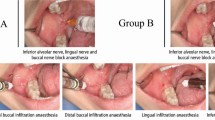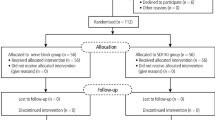Abstract
Introduction Intraligamentary local anaesthesia (ILA) with articaine is described as an effective alternative to inferior alveolar nerve block (IANB) for extraction of posterior teeth in the mandible, with reduced risk of complications.
Aim To investigate ILA with 4% articaine and conventional syringe as a unique method for providing tooth extractions in the posterior mandible.
Materials and methods All consecutive teeth to be extracted in the posterior mandible were recruited to the study, within exclusion criteria, between 2002 and 2017 in one London NHS and private dental practice. Four percent articaine was given by ILA with a conventional syringe slowly at two points lingual and two points buccal adjacent to each tooth. Extraction procedures were all performed flapless. Heavily broken-down teeth (n = 43) were extracted by sectioning of roots, guttering and elevation with luxators using socket preservation techniques. Demographic, quantitative and qualitative data were collected at initial appointments and up to 15 years at review.
Results The median age was 64 years (interquartile range 17). Teeth extracted included 272 mandibular molars and second premolars, due to periodontal disease (34%), irreversible pulpitis (29%) or posterior tooth fracture (27%). The majority of extractions were second molars (44%), followed by first molars (29%), second premolars (17%) and third molars (10%). Sufficient anaesthesia was achieved within five minutes for all extractions. Procedures lasted less than 30 minutes. Patient feedback reported that the extraction using ILA was quicker than expected and painless, with limited anaesthesia of tissues other than the teeth to be extracted. Numeric rating scale (NRS) scores for pain (0-10) were all less than 3. No complications were recorded.
Conclusion The ILA anaesthetic technique is effective for the purpose of a broad range of posterior tooth extractions in the mandible and within certain clinical parameters. It mitigates risks, including nerve injury and cardiovascular disturbances, associated with repeated IANB. This is the largest study of its kind and is conducted in primary care.
Key points
-
Demonstrates that intraligamentary local anaesthesia (ILA) with 4% articaine is effective for posterior mandibular extractions in many clinical situations.
-
Provides information on the technique for ILA in primary dental care, with patient feedback.
-
Raises awareness of the techniques for anaesthesia to reduce risk associated with nerve injury.
This is a preview of subscription content, access via your institution
Access options
Subscribe to this journal
Receive 24 print issues and online access
$259.00 per year
only $10.79 per issue
Buy this article
- Purchase on Springer Link
- Instant access to full article PDF
Prices may be subject to local taxes which are calculated during checkout



Similar content being viewed by others
References
Olley R C, Renton T F P, Frost, P M. Intraligamentary Local Anaesthesia for Posterior Mandibular Extractions. Dent Update 2020; 47: 2013-2016.
Malamed S F. The periodontal ligament (PDL) injection: an alternative to inferior alveolar nerve block. Oral Surg Oral Med Oral Pathol 1982; 53: 117-121.
Shabazfar N, Daublander M, Al-Nawas B, Kammerer P W. Periodontal intraligament injection as alternative to inferior alveolar nerve block-meta-analysis of the literature from 1979 to 2012. Clin Oral Investig 2014; 18: 351-358.
Garlsto G A, Gaffen A S, Lawrence H P, Tenenbaum H C, Haas D A. Occurrence of paresthesia after dental local anaesthetic administration in the United States. J Am Dent Assoc 2010; 141: 836-844.
Mehdizadeh A. Anaesthesia: A sense of balance. Br Dent J 2017; 223: 746.
Pogrel M A, Thamby S. Permanent nerve involvement resulting from inferior alveolar nerve blocks. J Am Dent Assoc 2000; 131: 901-907.
Kammerer P W, Adubae A, Buttchereit I, Thiem D G E, Daublander M, Frerich B. Prospective clinical study comparing intraligamentary anaesthesia and inferior alveolar nerve block for extraction of posterior mandibular teeth. Clin Oral Investig 2018; 22: 1469-1475.
Reitz J, Reader A, Nist R, Beck M, Meyers W J. Anaesthetic efficacy of the intraosseous injection of 0.9 mL of 2% lidocaine (1: 100, 000 adrenaline) to augment an inferior alveolar nerve block. Oral Surg Oral Med Oral Pathol Oral Radiol Endod 1998; 86: 516-523.
Kanaa M D, Whitworth J M, Corbett I P, Meechan J G. Articaine buccal infiltration enhances the effectiveness of lidocaine inferior alveolar nerve block. Int Endod J 2009; 42: 238-246.
Awal D H, Yilmaz Z, Osailan S, Renton T. Articaine-only buccal infiltrations for mandibular molar extractions: an alternative to inferior dental nerve blocks. Dent Update 2017; 44: 838-845.
Thiem D G E, Schnaith F, Van Aken CM E et al. Extraction of mandibular premolars and molars: comparison between local infiltration via pressure syringe and inferior alveolar nerve block anaesthesia. Clin Oral Investig 2018; 22: 1523-1530.
Rayati F, Noruziha A, Jabbarian R. Efficacy of buccal infiltration anaesthesia with articaine for extraction of mandibular molars: a clinical trial. Br J Oral Maxillofac Surg 2018; 56: 607-610.
Renton T. Optimal Local Anaesthesia for Dentistry. Prim Dent J 2019; 7: 51-61.
Endo T, Gabka J, Taubenheim L. Intraligamentary anaesthesia: benefits and limitations. Quintessence Int 2008; 39: e15-e25.
Pradhan R, Kulkarni D, Shetty L. Evaluation of Efficacy of Intraligamentary Injection Technique for Extraction of Mandibular Teeth - A Prospective Study. J Clin Diagn Res 2017; 11: ZC110-ZC113.
Olley R C, Andiappan M, Frost P M. An up to 50-year follow-up of crown and veneer survival in a dental practice. J Prosthet Dent 2018; 119: 935-941.
Hopman A J G, Baart J A, Brand H S. Articaine and neurotoxicity - a review. Br Dent J 2017; 223: 501-506.
Kanaa M D, Whitworth J M, Corbett I P, Meechan J G. Articaine and lidocaine mandibular buccal infiltration anaesthesia: a prospective randomized double-blind cross-over study. J Endod 2006; 32: 296-298.
McEntire M, Nusstein J, Drum M, Reader A, Beck M. Anaesthetic efficacy of 4% Articaine with 1: 100,000 adrenaline versus 4% articaine with 1: 200,000 adrenaline as a primary buccal infiltration in the mandibular first molar. J Endod 2011; 37: 450-454.
Daublander M, Muller R, Lipp M D. The incidence of complications associated with local anaesthesia in dentistry. Anesth Prog 1997; 44: 132-141.
FGDP. Research Competencies Framework. 2007. Available at https://www.fgdp.org.uk/sites/fgdp.org.uk/files/docs/in-practice/Research/researchcompetencies.pdf (accessed October 2020).
Sirintawat N, Sawang K, Chaiyasamut T, Wongsirichat N. Pain measurement in oral and maxillofacial surgery. J Dent Anesth Pain Med 2017; 17: 253-263.
Olley R C, Renton T, Frost P M. Observational study investigating tooth extraction and the shortened dental arch approach. J Oral Rehabil 2017; 44: 610-616.
Meechan J G. The use of the mandibular infiltration anaesthetic technique in adults. J Am Dent Assoc 2011; 142 Suppl: 19S-24S.
Dower J S J, Barniv Z M. Periodontal ligament injection: review and recommended technique. Gen Dent 2004; 52: 537-542.
Currie C C, Meechan J G, Whitworth J M, Corbett I P. Is mandibular molar buccal infiltration a mental and incisive nerve block? A randomized controlled trial. J Endod 2013; 39: 439-443.
Dumbrigue H B, Lim M V, Rudman R A, Serraon A. A comparative study of anaesthetic techniques for mandibular dental extraction. Am J Dent 1997; 10: 275-278.
Kaufman E, LeResche L, Sommers E, Dworkin S F, Truelove E L. Intraligamentary anaesthesia: a double-blind comparative study. J Am Dent Assoc 1984; 108: 175-178.
Kalsi A S, Kalsi J S, Bassi S. Alveolar ridge preservation: why, when and how. Br Dent J 2019; 227: 264-274.
Roberts G J, Simmons N B, Longhurst P, Hewitt P B. Bacteraemia following local anaesthetic injections in children. Br Dent J 1998; 185: 295-298.
Anneroth G, Danielsson K H, Evers H, Hedstrom K G, Nordenram A. Periodontal ligament injection. An experimental study in the monkey. Int J Oral Surg 1985; 14: 538-543.
Froum S J, Tarnow D, Caiazzo A, Hochman M N. Histologic response to intraligament injections using a computerized local anaesthetic delivery system. A pilot study in mini-swine. J Periodontol 2000; 71: 1453-1459.
Austin R S, Olley R C, Ray-Chaudhuri A, Gallagher J E. Oral disease prevention for older people. Prim Dent Care 2011; 18: 101-106.
Olley R C, Sehmi H. The rise of dentine hypersensitivity and tooth wear in an ageing population. Br Dent J 2017; 223: 293-297.
Acknowledgements
The authors wish to acknowledge the support of all nurses, technical and support staff that helped contribute data collection for service evaluation at the dental practice.
Author information
Authors and Affiliations
Corresponding author
Ethics declarations
The authors confirm there are no conflicts of interest.
Rights and permissions
About this article
Cite this article
Olley, R., Renton, T. & Frost, P. A 15-year unique observational study of intraligamentary local anaesthesia for posterior mandibular extractions. Br Dent J (2021). https://doi.org/10.1038/s41415-020-2350-8
Received:
Accepted:
Published:
DOI: https://doi.org/10.1038/s41415-020-2350-8



